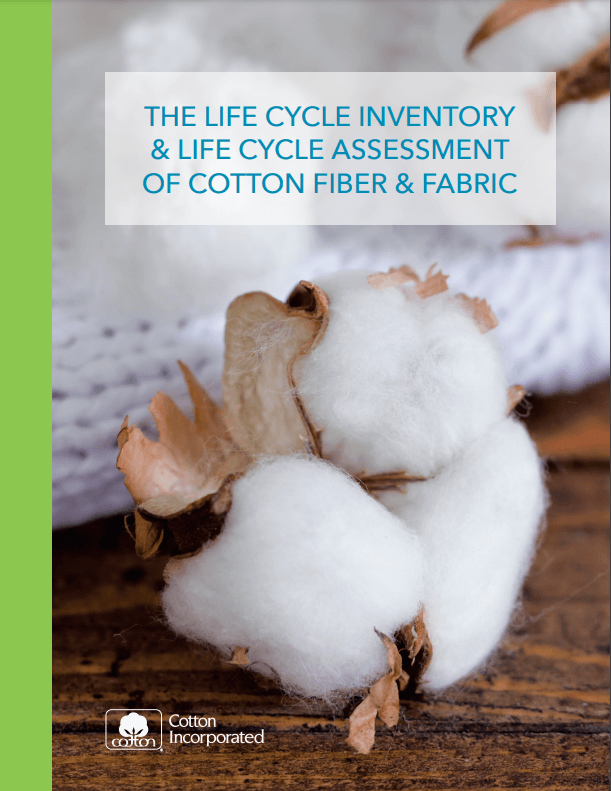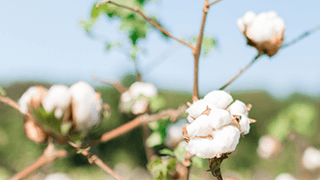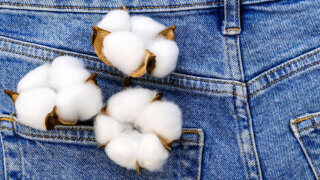Life Cycle Assessment of Cotton
Know the Environmental Impact of Your Textile Products
From fiber sourcing to product end of life, stakeholders and consumers alike expect manufacturers, brands, and retailers to know the environmental impact of their textile products and take action to reduce it. Cotton Life Cycle Assessments (LCA) are a valuable tool for industry decision-makers who need to know how to accomplish that efficiently and effectively. Through rigorous science and data analysis, cotton LCAs enable the supply chain to identify key environmental impact areas and benchmark success over time.
The Cotton Foundation has completed the most comprehensive assessment of cotton product life cycles to date: The Life Cycle Inventory & Life Cycle Assessment of Cotton Fiber & Fabric.
Download the full summary on this cotton LCA, listen to the webinar below for the synopsis, and then continue learning about cotton sustainability in the U.S. and Australia at cottonleads.org.
TERMS TO KNOW (click to flip)
A measure of greenhouse gas emissions, such as CO2 and methane.
view in glossaryThe total raw energy used-for example, the energy content of the coal used to generate electricity.
view in glossaryA measure of emissions that cause acidifying effects to the environment. An example impact is acid rain.
view in glossaryEutrophication covers all potential impacts of excessively high levels of macronutrients, the most important of which are nitrogen (N) and…
view in glossaryA measure of air emissions that contribute to the depletion of the stratospheric ozone layer.
view in glossaryA measure of emissions of precursors that contribute to ground level smog formation.
view in glossaryWater that is removed from a lake, stream or aquifer and not returned to the watershed it was taken from….
view in glossaryAny water that is withdrawn from a lake, stream or aquifer. This includes water used for power generation.
view in glossaryParticulate matter air emissions such as dust.
view in glossaryA representation of the consumption of non-renewable resources leading to a decrease in their future availability.
view in glossary
Life Cycle Assessment of Cotton Webinar
How do your industry decisions impact the earth?
Hear from Cotton Incorporated’s Mark Messura, Senior Vice President of Global Supply Chain Marketing, and Dr. Ed Barnes, Senior Director of Agricultural and Environmental Research, as they discuss highlights from the cotton LCA including valuable insight for decision-makers in the textile industry. This presentation will identify key impact areas and elaborate on environmental benchmarking for cotton.
Download the Life Cycle Assessment Webinar slides.
Originally played April 20, 2017
Webinar Q&A
What is a life cycle inventory?
A life cycle inventory is a database to store data needed to conduct a life cycle assessment.
Have you ever made an energy analysis in order to complete an LCI for cotton?
Yes. Tracking all of the energy used is a key component of a life cycle assessment.
What is blue water consumption?
Blue water consumption is water that is removed from the ground, stream, or lake but not returned to the watershed it was taken from.
Is this LCA transferable to cotton nonwoven products too?
The agricultural phase would apply to nonwovens, but the other phases of the study would not.
Why didn’t you compare your results with other fibers used in textile manufacturing for example?
A challenge for comparing any LCA data is being sure the background data is comparable.
Were there differences in results for conventional cotton versus organic cotton?
We did not collect data on organic cotton as our priority was to characterize the most common global cotton practices. Organic is less than one percent of the world’s cotton.
How does the lifecycle of 1 kg of cotton compare to 1 kg of Tencel or Modal?
We do not have a global average Tencel or Modal LCA that is ISO certified that would allow comparison with our current study.
Do you track the amount of water used in growing cotton and the production of the material?
We tracked all of the inputs used in growing cotton including water, energy, and fertilizer.
For this LCA, where was the use-phase evaluated? How many laundering cycles were considered?
Use phase data was collected in the U.S., China, Japan, Italy, Germany and the United Kingdom. Survey responses indicated that the average global consumer was washing a polo shirt about 20 times during the life cycle (first use), but often would use more than once per wash.
What do cotton producers think about utilizing hemp as it pertains to cover crops and rotational crops?
Hemp could be a feasible rotational crop. We have had studies to use flax as a winter crop in a double cropping system.
How do these results stack up vs. lower technology cotton producers?
Many of the regions in China and India where data was collected had predominately small holder farmers. Therefore, they are represented in the global average.
With waterless methods being used across the industry, are you studying this (i.e. How much water is actually being saved)?
We have evaluated several low-water technologies for cotton documenting the benefits and opportunities versus conventional cotton wet processing methods.
Are all cotton-producing countries applying these same steps to improve cotton fiber production as discussed (i.e. targeted fertilization of crops and targeted watering)?
Yes. At some level, all cotton producers are trying to find ways to make better use of their inputs. In the U.S. and Australia, producers are using advanced technologies such as in-the-field sensors, but even in India, the government is sponsoring programs to help farmers increase input efficiency through education on best management practices.
Did this particular LCA explore the end of life cycle of cotton that is not recycled and that degrades in landfills? Would this affect the water impact/global warming impact when these fibers begin to degrade back into the environment?
We did assume the carbon capture in the cotton fiber was re-emitted to the atmosphere at the time of disposal.
Can cotton be grown indoors and without soil, like how AeroFarms grows greens in an urban environment?
Yes. Cotton can be grown using a system like the one used by AeroFarms.
If carbon dioxide is being used by the plant, how is this causing issues for people?
Cotton is helping humans by converting the carbon dioxide that we exhale into oxygen that we inhale.
How do these results compare to other types of cotton, e.g. organic? And to the previous Cotton Inc. LCA results conducted?
We did not collect data on organic cotton as our priority was to characterize the most common global cotton practices, and organic is less than 1% of the world’s cotton. The results of this updated study were very similar to our last study for the agricultural and textile phases. The impact in all of the indicators was lower in the consumer phase as we considered a global versus a U.S. consumer in the latest study.
Answers were provided by the webinar presenter, Dr. Ed Barnes. No responsibility is assumed for the use of this information and no express or implied warranties or guarantees are made.



